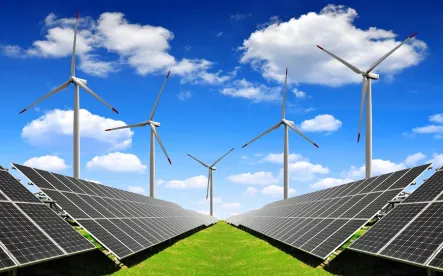President Donald Trump signed an Executive Order on March 28, 2017, entitled “Promoting Energy Independence and Economic Growth” (“Order”), which is designed to prompt reconsideration, and in some cases revocation, of the Obama Administration’s actions to address greenhouse gas emissions and climate change. The Order directs several federal agencies to review, and possibly withdraw, specific policy initiatives like the Environmental Protection Agency (“EPA”) Clean Power Plan rulemaking and the U.S. Department of the Interior (“Interior”) 2015 and 2016 rules on oil and gas production on federal lands. In addition, the Order directs the U.S. Council on Environmental Quality (“CEQ”) to rescind its 2016 final guidance document regarding the consideration of greenhouse gas emissions and climate change impacts in environmental reviews performed under the National Environmental Policy Act (“NEPA”). More broadly, the Order also directs all federal agencies to review “all agency actions” that “potentially burden the development or use of domestically produced energy resources.”
As discussed in greater detail below, the Order may have far-reaching implications for U.S. policy on energy production, greenhouse gas regulation, and climate change that could have spillover impacts for energy infrastructure development. A vigorous debate is certain to follow with interested stakeholders evaluating strategic options including notice and comment rulemaking, litigation, and legislative advocacy.
WHAT THE ORDER DIRECTS FEDERAL AGENCIES TO UNDERTAKE
President Trump’s Order adopts two separate approaches. First, the Order requires an agency-by-agency review of “all agency actions” that could “burden” domestic energy production. Second, the Order catalogues specific policies or regulatory programs that the relevant agency must review and potentially revoke.
Agency Review Of Regulations That Potentially Burden Domestic Energy Resource Development Or Use
The Order directs the heads of all federal agencies to review “all existing regulations, orders, guidance documents, policies, and any other similar agency actions … that potentially burden the development or use of domestically produced energy resources.” The Order further directs that the agency review should pay “particular attention” to potential impacts on oil, natural gas, coal, and nuclear energy resources.
Under the Order, “burden” means “to unnecessarily obstruct, delay, curtail, or otherwise impose significant costs on the siting, permitting, production, utilization, transmission, or delivery of energy resources.” Agency heads will likely struggle with interpreting how to assess whether a regulation, policy, or action is “unnecessary” particularly where the Order carves out from review actions that are mandated by law or necessary for the public interest. The Order creates a tension between costs and benefits by establishing a policy directive that “necessary and appropriate environmental regulations comply with the law, are of greater benefit than cost, when permissible, … and are developed through transparent processes that employ the best available peer-reviewed science and economics.”
The Order also establishes the following timeline for this agency-by-agency review:
-
By May 12, 2017: Agency heads must submit a plan for their regulatory reviews to the Director of the Office of Management and Budget;
-
By July 26, 2017: Agency heads should submit a draft report detailing any agency actions that potentially burden development or use of domestic energy resources;
-
By September 24, 2017: Agency heads must finalize their report, unless the Office of Management and Budget extends the deadline. [1]
Specific Federal Actions Under Review Or Revoked Outright
President Trump’s Order also targets specific federal actions for review or outright revocation or withdrawal. The Order directs Scott Pruitt, EPA’s Administrator, and Interior Secretary Ryan Zinke to review the final rules underpinning two Obama Administration programs within their jurisdiction. EPA must “review” the final rule underlying the Clean Power Plan[2] and other rulemaking efforts targeting carbon and greenhouse gas emissions from stationary sources and electric generating units.[3] At Interior, the Order directs Secretary Zinke to review four final rules regarding oil and gas leases and production [4] within Interior’s jurisdiction. The Order requires that Administrator Pruitt and Secretary Zinke notify Attorney General Jeff Sessions with respect to any action taken regarding these rules so that the Department of Justice may take appropriate action in any pending litigation involving these rules.
The Order also takes additional action relative to other federal regulatory programs, including:
-
Revoking a series of Presidential actions from the Obama Administration, including;
-
Exec. Order 13653, “Preparing the United States for the Impacts of Climate Change” (Nov. 1, 2013);
-
Presidential Memorandum, “Power Sector Carbon Pollution Standards” (Jun. 25, 2013);
-
Presidential Memorandum, “Mitigating Impacts on Natural Resources from Development and Encouraging Related Private Investment” (Nov. 3, 2015);
-
Presidential Memorandum, “Climate Change and National Security” (Sept. 21, 2016);
-
Report of the Executive Office of the President, “The President’s Climate Action Plan” (Jun. 2013); and
-
Report of the Executive Office of the President, “Climate Action Plan Strategy to Reduce Methane Emissions” (Mar. 2014);
-
-
Directing the CEQ to rescind its August 5, 2016 final guidance document regarding federal agencies’ consideration of greenhouse gas emissions and climate change during NEPA reviews; [5]
-
Disbanding the Interagency Working Group on Social Cost of Greenhouse Gases and withdrawing a series of technical support and guidance documents addressing the “social cost of carbon”; [6] and
-
Ordering Interior Secretary Zinke to amend or withdraw the Secretary’s Order 3338 and “lift any and all moratoria on Federal land coal leasing activities” related to that order.
IMPLICATIONS
Although President Trump’s Order may have dramatic effects on U.S. energy and environmental policy, especially for federal permitting of energy production activities or energy infrastructure projects, this change in policy direction may not take full effect for some time. The Order gives immediate effect to certain policy changes by withdrawing or revoking policy documents. But other changes, like analyzing and withdrawing or rewriting the regulations implementing the Clean Power Plan, may take several years. Requirements of the federal Administrative Procedure Act mandate that the EPA issue notice of any proposed change to the regulation, solicit public comment, and create an administrative record that presents a reasoned analysis supporting any change to the existing regulations. [7]
In fulfilling those requirements, the agency will have to explain -- as a legal, policy, and scientific matter -- why it is changing the position staked out in the Clean Power Plan. [8] EPA undoubtedly will face litigation in court regarding any change to this rulemaking, and therefore the agency likely will take the time to ensure that its rulemaking process withstands judicial scrutiny. In addition, given EPA’s endangerment finding regarding greenhouse gases, the agency is obligated to regulate those gases under the Clean Air Act. As such, even if EPA were successful in withdrawing the Clean Power Plan, the agency would likely face demands to take other action to fulfill its duty to regulate greenhouse gases under the Clean Air Act.
The Trump Administration will face similar procedural obstacles if it decides to withdraw or change federal regulations following the conclusion of the agency-by-agency review. At each step in the administrative process there will be opportunities for stakeholders to engage in what is certain to be a vigorous debate about the future of federal greenhouse gas emissions and climate change policy.
Certain components of the Order are likely to have more immediate and significant impacts on federal agencies’ actions. For example, rescinding CEQ’s greenhouse gas emissions and climate change final guidance document may remove significant environmental analysis from federal reviews under the NEPA. Limiting or eliminating consideration of such broad environmental issues in federal permitting reviews may streamline federal permitting for infrastructure significantly, shortening project development timelines and lowering development costs. On the other hand, the Order may have little impact on state permitting processes.
President Trump’s Order is significant and may have far-reaching impacts on U.S. policy on energy production, greenhouse gas regulation, and climate change. Stakeholders -- utilizing the administrative, judicial, and legislative processes -- will have ample opportunity to participate in shaping the Order’s breadth and full effect going forward.
[1] The Order requires that this final report be completed “within 180 days of the date of this order.” We note that the 180th day falls on September 24, 2017, which is a Sunday.
[2] See K&L Gates LLP’s analyses of these rulemaking efforts, “EPA’s Clean Power Plan: A Regional Analysis” (Sept. 11, 2015), available at http://www.klgates.com/epas-clean-power-plan-a-regional-analysis-09-11-2015/, and “EPA’s Clean Power Plan: Structure, Implications for the Grid, and Next Steps” (Aug. 13, 2015), available at http://www.klgates.com/epas-clean-power-plan-structure-implications-for-the-grid-and-next-steps-08-13-2014/.
[3] Already, EPA has signaled its intention to withdraw one of these rulemaking efforts, the October 2015 “Federal Plan Requirements for Greenhouse Gas Emissions From Electric Utility Generating Units Constructed on or Before January 8, 2014; Model Trading Rules; Amendments to Framework Regulations” proposed rule, in the pre-publication version of the Federal Register for April 3, 2017, available at https://s3.amazonaws.com/public-inspection.federalregister.gov/2017-06518.pdf.
[4] See K&L Gates LLP’s previous analysis of the Department of the Interior’s rule regarding hydraulic fracturing on federal and Indian lands, “Federal Judge: Authority Lacking for Regulation of Hydraulic Fracking” (Jul. 1, 2016), available at http://www.klgates.com/federal-judge-authority-lacking-for-regulation-of-hydraulic-fracking-07-01-2016/.
[5] See K&L Gates LLP’s previous analysis of this guidance document, “CEQ Issues Final Greenhouse Gas Guidance Directing Federal Agencies to Consider Climate Change in their NEPA Reviews” (Aug. 4, 2016), available at http://klgates.com/ceq-issues-final-greenhouse-gas-guidance-directing-federal-agencies-to-consider-climate-change-in-their-nepa-reviews-08-04-2016/.
[6] In place of the guidance documents regarding the “social cost of carbon,” the Order directs agencies to use the guidance in OMB Circular A-4, available at https://www.transportation.gov/sites/dot.gov/files/docs/OMB%20Circular%20No.%20A-4.pdf, when “monetizing the value of changes in greenhouse gas emissions resulting from regulations, including with respect to the consideration of domestic versus international impacts and the consideration of appropriate discount rates.”
[7] Under the Administrative Procedure Act, “rule making” refers to an “agency process for formulating, amending, or repealing a rule.” 5 U.S.C. § 551(5). Therefore, the statute’s requirements for rulemaking, such as public notice and opportunity for public participation, apply to the repeal or withdrawal of a federal regulation. See 5 U.S.C. § 553 (outlining the rulemaking process).
[8] Federal courts demand that agencies explain the basis for a change in policy. Motor Vehicles Mfrs. Ass’n of the U.S., Inc. v. State Farm Mutual Auto. Ins. Co., 463 U.S. 29, 42 (“[A]n agency changing its course by rescinding a rule is obligated to supply a reasoned analysis for the change beyond that which may be required when an agency does not act in the first place”); F.C.C. v. Fox Television Stations, Inc., 556 U.S. 502, 515 (2009) (“[T]he agency need not always provide a more detailed justification than what would suffice for a new policy created on a blank slate. Sometimes it must—when, for example, its new policy rests upon factual findings that contradict those which underlay its prior policy; or when its prior policy has engendered serious reliance interests that must be taken into account”). The U.S. Supreme Court has explained that an agency may justify its change where “the new policy is permissible under the statute, that there are good reasons for it, and that the agency believes it to be better, which the conscious change of course adequately indicates.” Id.





 />i
/>i
